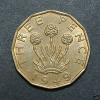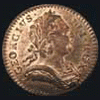Hmm...if the steel core of the coins is 'soft' magnetic material, like mild steel,
the the induced magnetism will indeed slowly reduce.
To create the effect, you would need a powerful magnetic field that doesn't change polarity.
Indeed, how to de-magnetise something is to use a coil powered off ac mains which reverses 100 times a second,
and slowly draw it away. ( Remember the 'wand' that the old tv engineer used when your tube tv screen went funny colours?)
Magnetising ( or what magnet manufacturers call 'charging' or 'energising') can indeed be achieved using a single
high-level pulse of DC current, like what a capacitive discharge will produce, or, in this case, a lightning 'strike'.
I put 'strike' in parentheses, since the big high current ( million + amps) discharge goes UP.
The high voltage 'leader' comes slowly down, finding a path, ionising a channel of air, and the ground discharges to the cloud.
Persistence of vision makes us see this as a downward 'stroke'.
Lightening rods etc spray electrons up to the cloud, discharging the cloud, and can actually make a big upward discharge more unlikely.
I'm selling my magnet collection. Special Offer:
Buy a North pole, and get a South pole free!!!
 Coinpublications.com
Coinpublications.com







